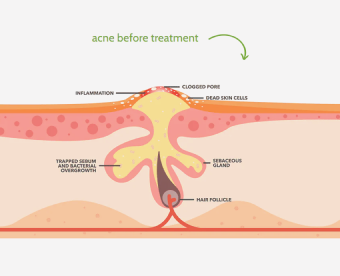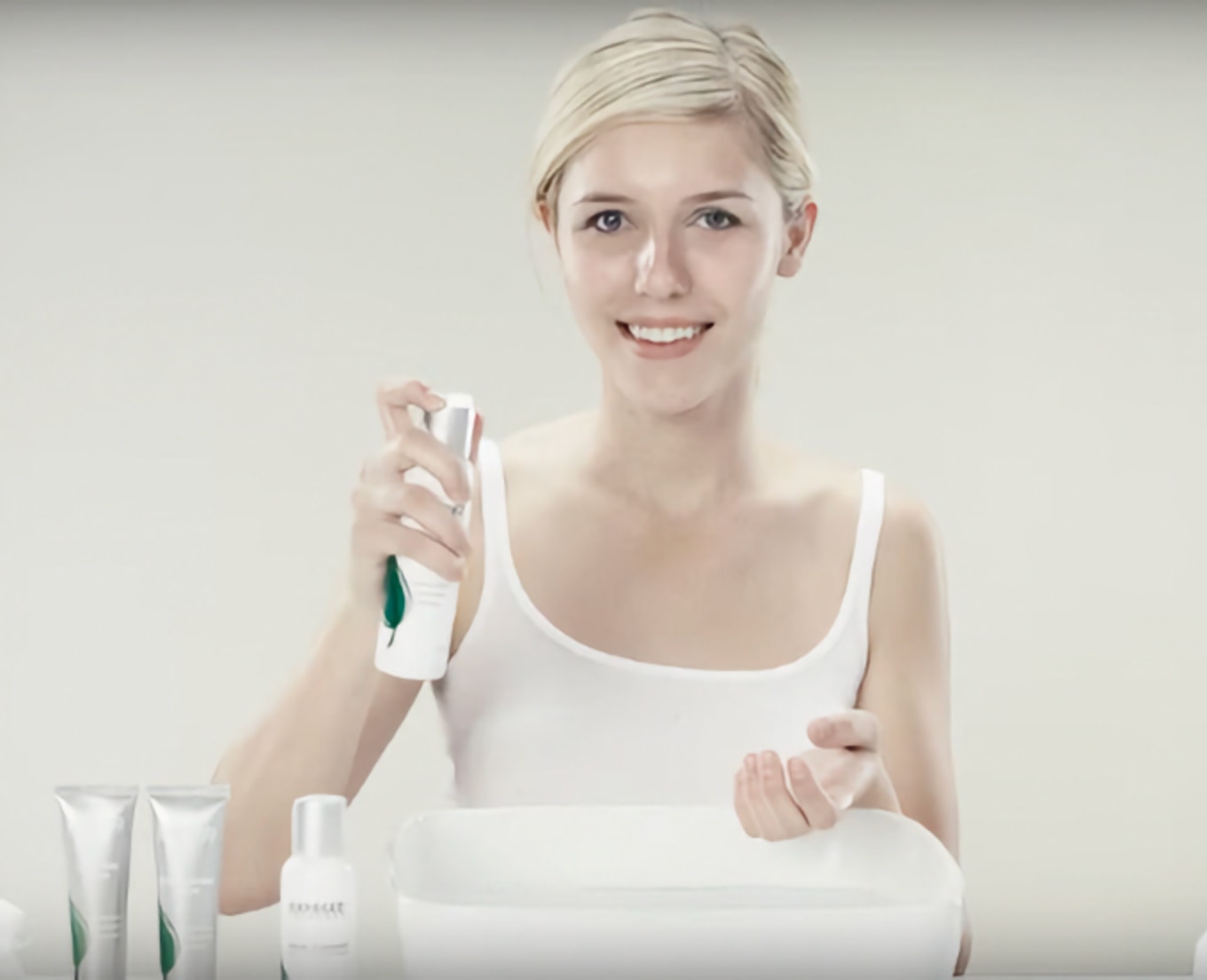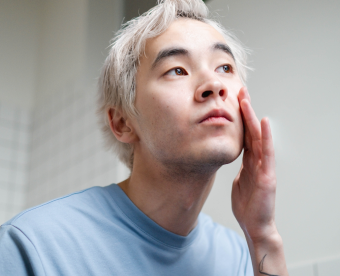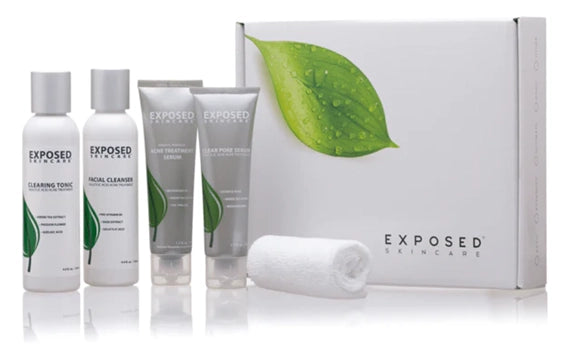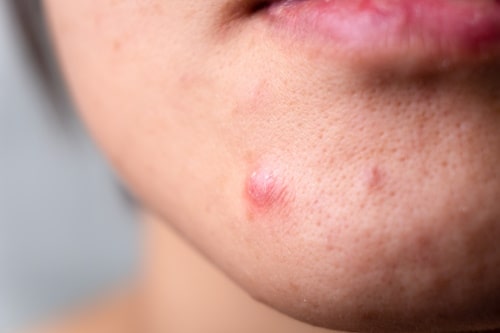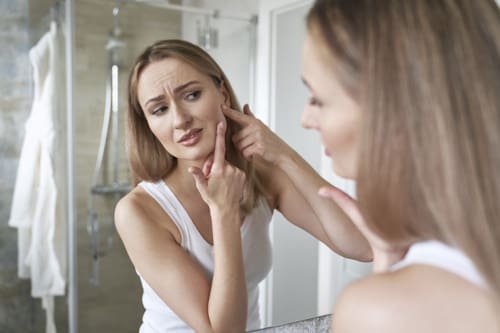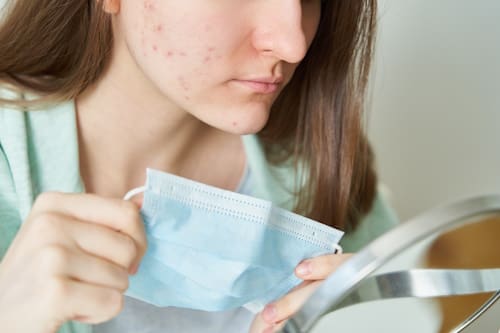Acne: it's an all-too-common skin ailment. Yet many methods and products promise to eradicate these unwanted blemishes. Among the latest trends in skin care are pimple patches or pimple stickers. But how do acne patches work, and are they the wonder treatment many claim to be?
Also read: How to choose the best acne treatment
Biggest Take-Aways:
- Pimple patches work best on open, pus-filled pimples, using hydrocolloid technology to absorb pus and oil from the acne lesion and accelerate healing.
- While patches are effective for treating individual pimples, they don't address the root causes of acne and may not prevent new breakouts.
- The effectiveness of acne patches can be limited, with less impact on blackheads, closed lesions or deep cystic acne trapped under the skin.
- For a more holistic approach to acne management, Exposed Skin Care offers a range of products targeting all causes of acne and potentially offering better long-term results than spot treatments.

Understanding Pimple Patches and Hydrocolloid Technology
Before we tackle the question, "How do acne patches work?" it's essential to understand these stickers and their technology.
What Are Pimple Patches?
Pimple patches are small adhesive stickers applied directly to a pimple or zit. They are often transparent or skin-toned, making them less noticeable and can be worn overnight or throughout the day.
Hydrocolloid Patches: The Science Behind It
Most pimple patches utilize hydrocolloid technology. A hydrocolloid patch is a type of wound-healing dressing that has been in use for several years, particularly for ulcers and sores. Recently, this technology has been adapted for acne treatment.
The hydrocolloid material is a gel-forming agent which can absorb moisture, making it an ideal solution for tackling acne lesions that ooze pus and other fluids. This substance provides a moist environment conducive to wound healing while absorbing excess fluids from the pimple.
So, How Do Acne Patches Work?
Now that we've established what acne patches are and the science behind them let's dive into the mechanics of how pimple patches work.
How Do Pimple Patches Work?
When a pimple patch is placed over a blemish, the hydrocolloid material absorbs the pus and oil from the acne lesion. This helps to dry out the pimple, thereby accelerating the healing process.
Furthermore, the patch serves as a physical barrier, protecting the spot from external irritants and preventing the temptation to pick or squeeze the pimple, which can lead to further inflammation and potential scarring.

The Limitations: Why Acne Patches Might Not Be the Best for Acne
While pimple patches can be effective for treating certain types of acne, they have their limitations. Notably, acne patches don't necessarily address the root causes of acne and may not be effective for all forms of this skin condition.
Pimple Patches Work Best on Open Lesions
Acne patches work best on open, pus-filled pimples or whiteheads. They are less effective on blackheads, closed lesions or deeper cystic acne trapped under the skin. Hydrocolloid patches absorb excess fluid and pus; they need an open lesion to do this effectively.
Acne Patches May Only Treat Symptoms, Not Causes
Pimple patches may treat the symptoms of acne (the individual pimples), but they don't necessarily tackle the root causes, such as excess oil production, clogged pores, or bacteria. Therefore, while patches can help manage breakouts, they might not prevent new ones from forming.
Potential Allergic Reactions
Though relatively rare, some people may be allergic to the adhesive used in the pimple patch or to ingredients like salicylic acid or tea tree oil that are sometimes included in the patch.

Choosing the Right Acne Patch
If you use pimple patches despite their limitations, here are a few things to consider when deciding which patch is best for you.
- The Type of Lesion: As mentioned earlier, pimple patches work best on open, pus-filled pimples. Therefore, if you're dealing with whiteheads or similar types of acne, hydrocolloid patches may be helpful.
- Ingredients: Some patches are infused with active ingredients like salicylic acid or tea tree oil to help treat the acne while the patch is on. However, these ingredients may irritate sensitive skin or cause an allergic reaction.
- Patch Size: Pimple patches come in various sizes. Smaller patches are useful for small pimples, while larger ones can cover a bigger breakout area.
Benefits of Using Exposed Skin Care for Acne Management
If you're seeking a more comprehensive approach to tackling acne, Exposed Skin Care could be the solution. As opposed to spot treatments like acne patches, this skincare line offers a range of products designed to manage acne holistically, targeting the root causes.
Here are some benefits of using Exposed Skin Care:
- Complete Acne Treatment: Exposed Skin Care targets all causes of acne, including excess oil, clogged pores, bacteria, and inflammation. This approach may be more effective for long-term management compared to spot treatments.
- Multiple Active Ingredients: The products include proven acne-fighting ingredients like salicylic acid, benzoyl peroxide, and natural elements like green tea and tea tree oil.
- Gentle on Skin: Unlike some acne treatments, Exposed Skin Care is designed to be gentle and non-irritating, suitable for all skin types.
- Preventive Care: With regular use, Exposed Skin Care can help prevent future breakouts, which can be a limitation of spot treatments like acne patches.
While acne patches can help manage individual pimples, a more comprehensive skincare routine like Exposed Skin Care could potentially offer better long-term results.
Conclusion
acne patches, notably those employing hydrocolloid technology, serve as a convenient tool for immediately managing specific types of acne, primarily open, pus-filled pimples. However, their scope is limited, and they may not effectively address all forms of acne or prevent future outbreaks, as they don't target the root causes of acne, such as excess oil production, clogged pores, or bacteria.
A comprehensive skincare routine is beneficial to complement or even substitute for spot treatments. This is where products like Exposed Skin Care come into play. By targeting all aspects of acne and offering a more holistic solution, such products can potentially lead to better long-term results.
In the battle against acne, understanding the benefits and limitations of available treatments can guide you in constructing a suitable skincare regimen, combining both immediate solutions like acne patches and comprehensive solutions like Exposed Skin Care.
FAQs
Q: Are acne patches effective for cystic acne?
A: Acne patches target surface blemishes and may not work on deeper acne. They may work on cystic acne, but they are not the most effective treatment. It’s best to see a dermatologist for proper treatment if you have cystic acne.
Q: Can acne patches make acne worse?
A: While pimple stickers can be a helpful tool in treating acne, they can also make acne worse if not used correctly. If you put the patch over your pimple before washing your skin, you’re essentially trapping dead skin cells and bacteria under the patch, which can inflame the pimple further. It’s important to wash your skin before putting the patch on.
Q: How do I use a hydrocolloid pimple patch?
A: First, wash your skin thoroughly and dry it. Then, put the patch over your pimple. Make sure that the patch is completely adhered to your skin. Leave the patch on for the recommended time and then remove it. Translucent stickers can make it easier to see when the patch is ready to be removed.
Q: Can pimple stickers actually work?
A: While pimple stickers are not a cure-all for acne, they are effective in helping to reduce inflammation and protect your skin while it heals. If used correctly, they can be a helpful tool in treating acne.
Q: Should I use a patch if I’m allergic to adhesives?
A: If you’re allergic to adhesives, you should avoid acne patches. The adhesive on the patch may cause an allergic reaction, which can further inflame your skin.
Q: Can pimple stickers help with painful pimples?
A: Pimple stickers can help with painful pimples by creating a barrier between the inflamed area and your outside environment. This helps reduce friction and irritation, alleviating some of the pain associated with pimples.
Q: Is it safe to use pimple patches every day?
A: While pimple patches are generally safe, using them daily may not be the best idea. Overuse of the patches can dry out your skin and cause irritation. Using the patches as a spot treatment is best, allowing your skin to heal in between applications.

